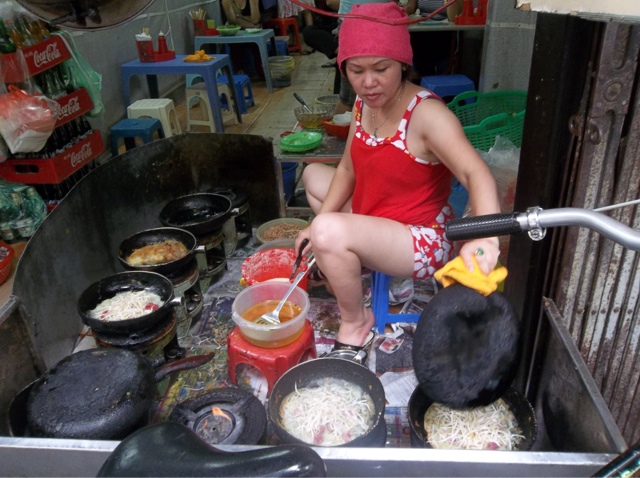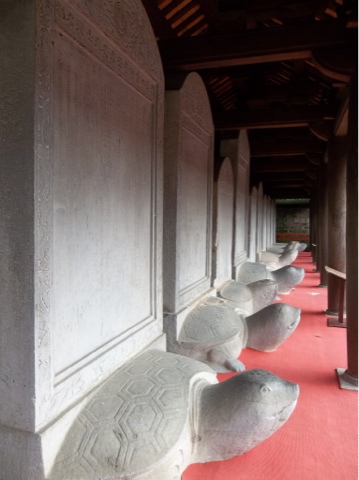Perhaps part of the reason that the museum was so empty is because not all of the exhibits are translated into English. An entire second floor full of prisoners' poetry is available only in Vietnamese, making it inaccessible to many Western tourists. Descriptions in English were usually brief and often poorly translated. Where care had been taken with an English translation, it was full of so many self-righteous adjectives that the communist zeal was palpable in the room. The French were "barbaric" and their "utter domination" and "complete repression" were the themes of the day.
Indeed, the French treated Vietnamese prisoners quite poorly at Hoa Lo Prison. The French demolished a prosperous village that specialized in portable stoves (Hoa Lo Village actually means "Village of Portable Earthen Stoves") in order to build the prison, one of the largest and most secure of its time in Indochina. The "Central Maison", as it was labeled (apparently the French often call prisons "Central House") stood in the middle of the town that regrew around it. As a result, though, people would often throw notes or supplies over the walls. This made the prison a hotbed of revolutionary activity during the 1930s and 1940s. Most of the Vietnamese revolutionary leadership had spent time there. But back to the French treatment of prisoners. They would keep them in tiger cages (underground pit with bamboo bars over the top), force them to wear unwieldy ladder-like devices around their necks, subject them to torture using canes or electricity, or execute them with a guillotine (one is still in the prison). They also would shackle both feet in place, the prisoners parallel in long lines.
According to the museum, after the liberation from French rule in 1945, the prison was maintained as a historical site until it was used to house American pilots gunned down and arrested. These pilots gave the place the tongue-in-cheek name of "Hanoi Hilton". Though the government now uses this fact to say that the treatment of US prisoners was exemplary - it was practically a Hilton hotel - the accounts of US soldiers tell a story of extreme torture, extraction of false statements condemning the US military activity (to be used as propaganda by the North Vietnam government), and general poor treatment. Like other Vietnamese tourist sites, the information provided had been carefully crafted to create an image of Vietnam as the persevering victim, attacked and oppressed by foreign powers but resilient to the end. None of these sites - from the Hoa Lo Prison to the War Remnants Museum (previously called the American War Crimes Museum) - ever mentions poor conduct on the part of the Viet Cong or the government. It is this constant need for scrutiny, for taking things with a grain of salt, that I find so exhausting about Vietnam tourism.
Fun facts about the prison, though: it is where John McCain spent a good portion of his time as a POW, and his flight suit is on display.
It is also where Douglas Peterson, an Air Captain in the army and future US Ambassador to Vietnam, was a POW. I had heard about Peterson before; while in central Vietnam I learned that during or after his ambassadorship he started a charity that teaches Vietnamese children how to swim. Despite the long coastline and numerous lakes and rivers, most Vietnamese cannot swim and drowning is a major cause of death.
After visiting the museum, I headed back to my hostel to check out. While there, I met four Israeli girls and one Italian woman in the lobby. They were just heading out to lunch and invited me along. We didn't walk far; the girls wanted to stop at a Kebab house about a block away. It want until about halfway through the meal that I realized this was, for them, like getting a burger would be for me. It's a taste of home while abroad, and nothing feels more familiar than your comfort food. Over lunch, I learned that the Israeli girls had just finished their army stints and were traveling until they started work or school. They had spent two month in China and were spending about a month in SE Asia, hitting many of the same countries that I did. It was amazing how many small things we had in common, from singing to medical interests. They were quite excited that I will be visiting Israel this summer. I asked if they thought they would live abroad, and all of them said they loved Israel and had no desire to live elsewhere. The Italian woman at lunch with us, who was perhaps 30, was a complete free spirit. I didn't get her whole story, but she had been traveling for quite some time, including a four-month stint in India. She was a lovely person to spend an afternoon with. I hope that I can go visit her in Italy at some point, but she doesn't plan on being back for several more years.
The rest of the afternoon was spent tying up loose ends, from paying my hostel bill to arranging a taxi to the airport and charging my various electronics (I needed about 30 hours of entertainment for the upcoming flights and layovers). My last task was venturing out to find food that I could bring with me for dinner.
While I had hoped to stop by a nearby Banh My place, the normal person wasn't there and the woman managing the store tried to rip me off. This simple task turned into a wild goose chase all over the Old Quarter, with people pointing me to cafes and me ordering and waiting only to find out that they didn't serve sandwiches and had instead fixed me a non-portable specialty.
It was exhausting running around, tackling language barriers (often with little success), and haggling away my last few VND. But it was very Hanoi, and after my frustrations passed I realized that it was an appropriate end to my time in Vietnam.
My first flight, to Hong Kong, was uneventful. I was seated with two other American college graduates traveling Asia before venturing into the real world, and it was fun sharing tips about Hong Kong for their upcoming stay there. It made me crave Butao pesto ramen and laugh at memories of the giant rubber duck. I hope they have a good time.
Upon reaching Hong Kong, David and I had a rather giddy reunion and celebrated with a western indulgence: Starbucks. After all, we would be staying up all night and the whipped cream-topped drinks looked too delicious to resist. With cheers, we downed our caffeine and headed to buy train tickets. But lest you think that all was smooth sailing, adventure awaited. We would catch the train out to Central to pick up our luggage, but the train wouldn't resume service until 6 am, too late to make our 7:30 flight. We would need to research other options. But for the time being, we enjoyed our fancy drinks and giggled deliriously all the way to Hong Kong Island. My time traveling alone was wonderful, but the best time is shared with friends.
We reached the apartment and our luggage with ease. But since there had been no hiccups - no delays or taxi breakdowns or apartment lock-outs - we had several hours to burn before returning to the airport. We considered going out, given that it was a Thursday night and we were well-caffeinated, but our host had to prepare lesson plans for his tutee and it wouldn't be the same without him and his droll commentary on the Hong Kong party scene. Instead, David and I decided to climb a mountain. We were already halfway up Victoria's peak, and there was little traffic at this hour on either the road or the pathway up. A bit delirious, we packed a backpack with cookies and a headlamp and set off. We had been warned about fist-sized banana spiders and their enormous webs, but nothing crossed our path during the ascent. We did, however, stop at a playground and make good use of the slides, rings, and spring animals.
Continuing to the peak, we were unable to see the other islands due to an incredibly thick fog. When we went to the traditional tourist lookout point, though, we could see the city glimmering beneath us. We lingered as long as we could, soaking up the city lights, the hazy pre-dawn, and the last vestiges of our amazing Asian adventure.
And don't worry, we made it to the airport with time to spare.
Spotted: monochrome outfits. These are quite popular in Vietnam, especially among the older generation. They are often in bright prints and the individual pieces would be rather difficult to wear in comination with anything else. But hey, they always make an outfit, which is more than I can say of my own poor fashion choices.
Also spotted: shoe shiners. I would get stopped on the street everyday that I wore sneakers by shoe shiners offering to buff them up a bit. My muddy, grungy, stinky sneakers were headed for the trash can and no shoe shining could return the bounce to their soles. It was a shock to me that they would even think to polish them. I wonder exactly what they would do.

















































